Items
Tag
Torture of Prometheus
-
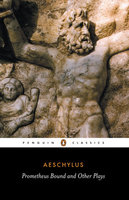 Prometheus Bound “Aeschylus (525–456 BC) brought a new grandeur and epic sweep to the drama of classical Athens, raising it to the status of high art. In Prometheus Bound the defiant Titan Prometheus is brutally punished by Zeus for daring to improve the state of wretchedness and servitude in which mankind is kept."
Prometheus Bound “Aeschylus (525–456 BC) brought a new grandeur and epic sweep to the drama of classical Athens, raising it to the status of high art. In Prometheus Bound the defiant Titan Prometheus is brutally punished by Zeus for daring to improve the state of wretchedness and servitude in which mankind is kept." -
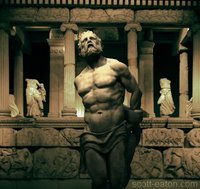 Prometheus and Digital Sculpture “The piece is my [Eaton’s] own interpretation of the Prometheus myth, and is not based on any existing sculptures.”
Prometheus and Digital Sculpture “The piece is my [Eaton’s] own interpretation of the Prometheus myth, and is not based on any existing sculptures.” -
 Prometheus, naked, chained to a rock, looking up at an eagle standing over him N/A
Prometheus, naked, chained to a rock, looking up at an eagle standing over him N/A -
 Prometheus Bound “In Greek mythology the Titan Prometheus stole fire from the gods on Mount Olympus to give to humanity. Furious, Zeus, king of the Olympians, ordered Prometheus forever chained to a rock, where each day an eagle would devour the Titan’s perpetually regenerating liver. This painting, which Rubens considered one of his most important works, represents the virtuoso artist at his absolute height. Working in collaboration, a common practice for master artists in Antwerp in the first two decades of the seventeenth century, Rubens and the famed animal and still-life painter Frans Snyders, who contributed the eagle, rendered the brutal tale of Prometheus with corresponding violence. The enormous bird’s beak rips open the Titan’s torso, exposing blood-soaked entrails. To gain purchase on the captive’s flesh, one of the eagle’s talons gouges Prometheus’s right eye. His left eye is locked on the predator, signaling he is fully aware of his torture, while his writhing legs, clenched fist, and tousled hair convey the Titan’s abject agony. Rubens, who intensively had studied the art he saw on his travels to Italy, Spain, and England, derived the hulking figure of Prometheus, with its broad frame and dense musculature, from prototypes by Michelangelo. The picture’s asymmetrical composition, in which Prometheus tumbles downward with his left arm almost reaching beyond the canvas, was inspired by a painting by Titian of the giant Tityus (1548–49; Museo del Prado, Madrid). Here Rubens masterfully synthesized and melded these sources with his own Baroque sensibilities. Christopher Atkins, from Philadelphia Museum of Art: Handbook. Philadelphia: Philadelphia Museum of Art, 2014, pp. 126–127.”
Prometheus Bound “In Greek mythology the Titan Prometheus stole fire from the gods on Mount Olympus to give to humanity. Furious, Zeus, king of the Olympians, ordered Prometheus forever chained to a rock, where each day an eagle would devour the Titan’s perpetually regenerating liver. This painting, which Rubens considered one of his most important works, represents the virtuoso artist at his absolute height. Working in collaboration, a common practice for master artists in Antwerp in the first two decades of the seventeenth century, Rubens and the famed animal and still-life painter Frans Snyders, who contributed the eagle, rendered the brutal tale of Prometheus with corresponding violence. The enormous bird’s beak rips open the Titan’s torso, exposing blood-soaked entrails. To gain purchase on the captive’s flesh, one of the eagle’s talons gouges Prometheus’s right eye. His left eye is locked on the predator, signaling he is fully aware of his torture, while his writhing legs, clenched fist, and tousled hair convey the Titan’s abject agony. Rubens, who intensively had studied the art he saw on his travels to Italy, Spain, and England, derived the hulking figure of Prometheus, with its broad frame and dense musculature, from prototypes by Michelangelo. The picture’s asymmetrical composition, in which Prometheus tumbles downward with his left arm almost reaching beyond the canvas, was inspired by a painting by Titian of the giant Tityus (1548–49; Museo del Prado, Madrid). Here Rubens masterfully synthesized and melded these sources with his own Baroque sensibilities. Christopher Atkins, from Philadelphia Museum of Art: Handbook. Philadelphia: Philadelphia Museum of Art, 2014, pp. 126–127.” -
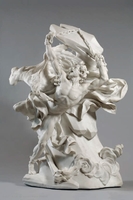 Prometheus, Chained to Mount Caucus, has his Liver Devoured by an Eagle “The Titan Prometheus, protector of men, stole fire from Mount Olympus. Furious, Zeus inflicted a terrible and cruel punishment on him. He chained him to the summit of Mount Caucasus, where an eagle came daily to peck at his liver, which constantly replenished itself. Prometheus, straining his every muscle, screams in agony. The instrument of his crime, the torch, lies at his feet.”
Prometheus, Chained to Mount Caucus, has his Liver Devoured by an Eagle “The Titan Prometheus, protector of men, stole fire from Mount Olympus. Furious, Zeus inflicted a terrible and cruel punishment on him. He chained him to the summit of Mount Caucasus, where an eagle came daily to peck at his liver, which constantly replenished itself. Prometheus, straining his every muscle, screams in agony. The instrument of his crime, the torch, lies at his feet.” -
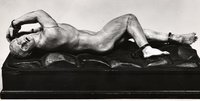 Untitled statuette “Statuette; ivory; carved; a nude figure in the form of Prometheus, who is shackled and chained at his wrists and ankle to a rock; the chains and rock are made of bronze, attached to a rectangular base by means of a screw with a washer in the form of a coin.”
Untitled statuette “Statuette; ivory; carved; a nude figure in the form of Prometheus, who is shackled and chained at his wrists and ankle to a rock; the chains and rock are made of bronze, attached to a rectangular base by means of a screw with a washer in the form of a coin.” -
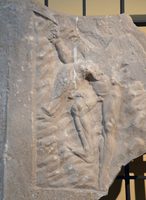 Untitled relief “Relief decorating the seating area entrances of the Roman Amphitheatre of Capua (Italy). It depicts Prometheus having his liver eaten by an eagle. Age of Hadrian (117-138 CE). (Capua Gladiator Museum)”
Untitled relief “Relief decorating the seating area entrances of the Roman Amphitheatre of Capua (Italy). It depicts Prometheus having his liver eaten by an eagle. Age of Hadrian (117-138 CE). (Capua Gladiator Museum)” -
 Untitled gem “Gem of glass paste imitating sard, engraved with Herakles with a bow, lion-skin and club; before him sits Prometheus, draped about the legs, with his hands chained above his head.”
Untitled gem “Gem of glass paste imitating sard, engraved with Herakles with a bow, lion-skin and club; before him sits Prometheus, draped about the legs, with his hands chained above his head.” -
 Herakles liberating Prometheus
Herakles liberating Prometheus
-
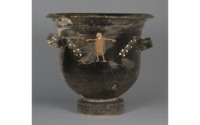 Gnathian Bell Krater “Black body with tendril of ivy leaves and grape clusters in added white. On the front, a figure of an old man with a swollen belly and an oversize phallus wearing a cloak stands in a rocky landscape. His wrists are bound. Below him to left is a crow. The scene is a parody of Prometheus bound to a rock having his liver eaten by an eagle.”
Gnathian Bell Krater “Black body with tendril of ivy leaves and grape clusters in added white. On the front, a figure of an old man with a swollen belly and an oversize phallus wearing a cloak stands in a rocky landscape. His wrists are bound. Below him to left is a crow. The scene is a parody of Prometheus bound to a rock having his liver eaten by an eagle.” -
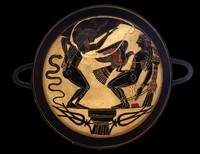 Laconic Kylix with Prometheus and Atlas “On this item we are able to admire one of the first known illustrations of the myth of Atlas, possibly directly inspired by the Theogony of Hesiod. Bearded Atlas bends at the knees under the weight of the heavenly vault dotted with stars that he has to carry, having been condemned by Zeus to keep heaven and earth separated. His punishment is associated with that of another Titan, his brother Prometheus, guilty of having given fire to man, and therefore bound to a pole and subjected to perpetual torture: an eagle pecks at his liver, which then regrows every night, only to be eaten again the following day. The linear plane on which the two Titans are depicted, possibly symbolising the Earth, rests on an imposing Doric column from which two lotus buds branch. The snake on the left may constitute a reference to the subterranean sphere of the underworld.”
Laconic Kylix with Prometheus and Atlas “On this item we are able to admire one of the first known illustrations of the myth of Atlas, possibly directly inspired by the Theogony of Hesiod. Bearded Atlas bends at the knees under the weight of the heavenly vault dotted with stars that he has to carry, having been condemned by Zeus to keep heaven and earth separated. His punishment is associated with that of another Titan, his brother Prometheus, guilty of having given fire to man, and therefore bound to a pole and subjected to perpetual torture: an eagle pecks at his liver, which then regrows every night, only to be eaten again the following day. The linear plane on which the two Titans are depicted, possibly symbolising the Earth, rests on an imposing Doric column from which two lotus buds branch. The snake on the left may constitute a reference to the subterranean sphere of the underworld.”